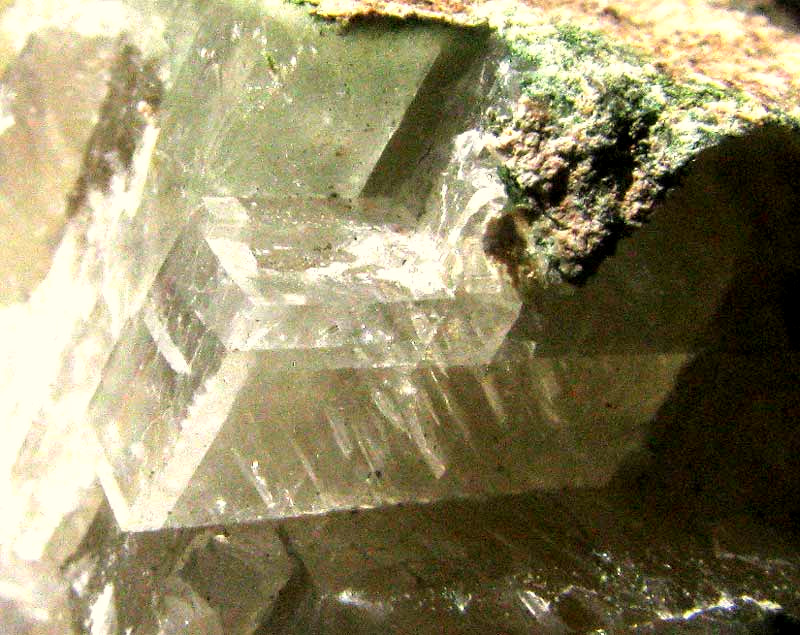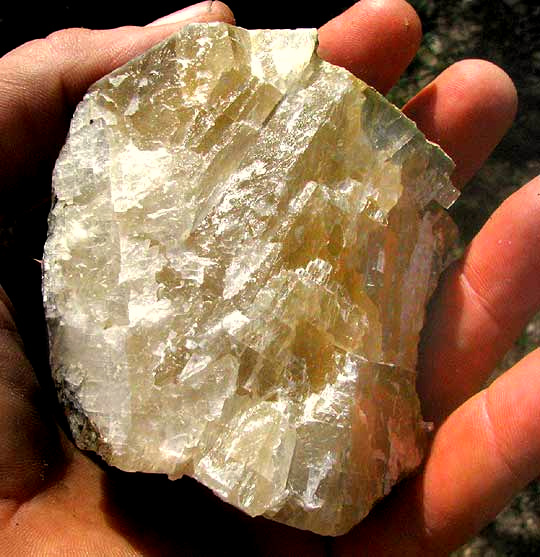Excerpts from Jim Conrad's
Naturalist Newsletter

from the June 30, 2013 Newsletter issued from the Frio Canyon Nature Education Center in the valley of the Dry Frio River in northern Uvalde County, southwestern Texas, on the southern border of the Edwards Plateau; elevation ~1750m (~5750 ft); N29.62°, W99.86°; USA
CALCITE CRYSTALS
The main reason Dave had invited us to his ranch was because he wanted to show us a special geological formation outcropping in a small area at the bottom of an arroyo, an arroyo being a streambed that's dry most of the time. Finally reaching the outcrop it was easy to see what Dave was talking about. All around us were outcroppings of more or less horizontal strata of limestone typical of the region, but here a dark rock seemed to extrude from the ground, its upper surface eroded into smoothish bumps, but the sides revealing a strange fibrous texture, the fibers standing vertically and parallel with one another. Dave had brought a hammer so he knocked off a hunk and handed it to me. Below you can see that where the rock broke from the dark outcrop its surface was smooth and shiny:

Notice all the flat surfaces scattered across the rock's face. This shows that the rock is crystalline. When it broke from the outcrop the breakage occurred along crystalline "cleavage planes" inside the rock.
A crystal is defined as a homogenous solid formed by a repeating, three-dimensional pattern of atoms, ions, or molecules and having fixed distances between constituent parts.
So, a crystal is pure (homogenous) and it becomes crystalline because its atoms, ions or molecules, during the crystallization process, consistently order themselves in a particular manner, depending on the shape and/or electrical charges of the atoms, ions or molecules. One outcome of this reality is that a crystal's shape is determined by the arrangement of its atoms, ions or molecules. In other words, a crystal's shape indicates to us how the crystal's component atoms, ions or molecules combined as the crystal formed.
Apparently millions of years ago something caused this tiny area of limestone to melt, forming magma. If magma cools slowly enough, crystals form -- the slower the cooling, the larger the resulting crystals. Lots of faults occur in our area, so maybe when one side of a fault slid past the other, the friction produced caused limestone near the fault line to melt, leading to our crystals.
Another possibility is that in our area -- though mostly to the south of where we were -- studies show that between 72 and 82 million years ago magma from deep inside the earth frequently rose up through the earth's crust, following fractures in the rock. Some of this uprisings of magma were issued as lava ejected from volcanoes, other magma barely reached the surface, and most magma didn't reach the surface at all. But wherever this magma passed, it melted nearby sedimentary rock -- our limestone -- so maybe such a nearby "igneous intrusion" melted our rock.
At the top of this page you can see a tiny corner of the crystalline rock Dave handed me.
Notice the structure shaped like a shoebox squashed a little to one side. That's a calcite crystal. Calcite crystals are recognized by their rhombohedral shape, rhombohedrons being solids bounded by six rhombic planes, a rhombus being four-sided, with opposite sides parallel and opposite angles equal. You can see that the angles of this crystal are consistently either of a certain acute angle (acute angles are narrower than right angles) while the others are obtuse (more open than right angles). Chemically, calcite is CaCO3, so these angles reveal how asymmetrical molecules of CaCO3 "settle" together during the crystallization process.
Actually, by calling this a calcite crystal I'm using some imprecise and, on a technical level, possibly misleading name. For, calcite is one of the most common minerals on Earth, and over 800 different forms have been described, all with their own names. Our rhombohedrons are just one form of Calcite. For example, stalactites hanging from the roofs of caves are mostly calcite. Also, some other crystal types have this shape and our crystal might be one of them, or a transition stage between them. Dolomite crystals look like calcite crystals; special optical tests must be performed to distinguish them. Dolomite is CaMg(CO3)2, which means that dolomite is basically calcite with some added magnesium. The more magnesium, the purer the form of dolomite. And we can guess that there's a bit of magnesium in our limestone, but we don't know how much.
Traditionally certain people have regarded calcite crystals as having metaphysical properties. Web pages can be found saying that calcite is a protecting, grounding and centering stone that can help bring inner peace. Also, "Calcite can ameliorate arguments in a relationship, and help maintain a practical balance between the people in the relationship."
If you drop a bit of acid on a calcite crystal -- even a weak acid like vinegar -- it'll fizz, at least a little, as the hydrogen in the acid combines with the calcium carbonate forming gaseous carbon dioxide.